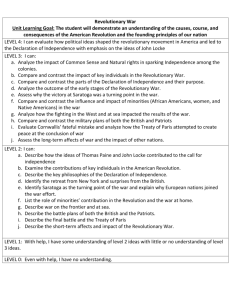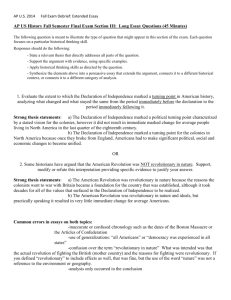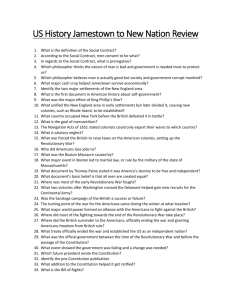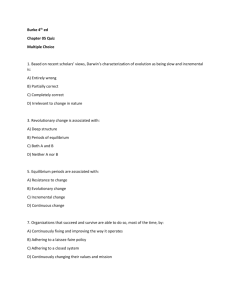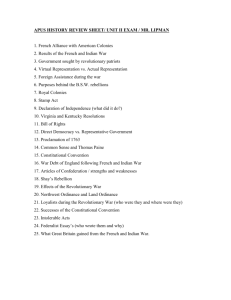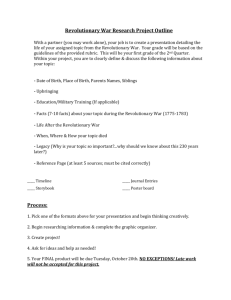Hannastown - Summer11-OROL-01
advertisement
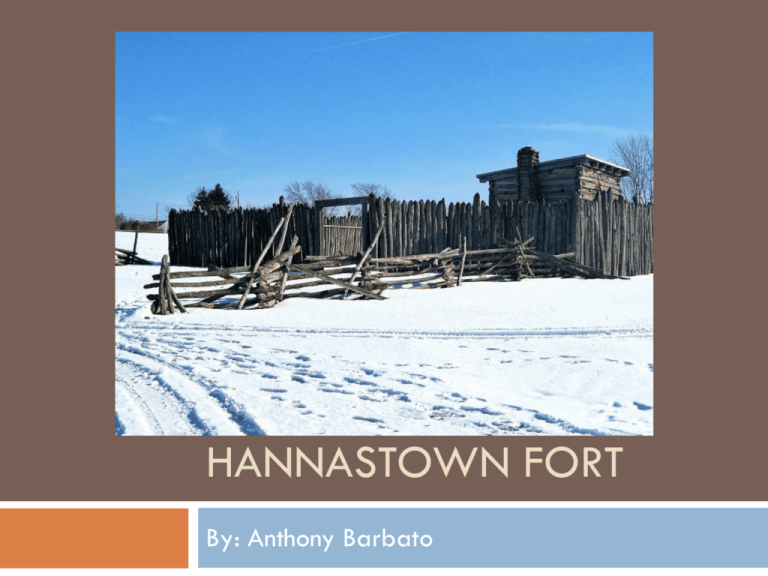
HANNASTOWN FORT By: Anthony Barbato Questions to think about… What is Hannastown Fort? Why was it built? What time period was Hannastown Fort in use? Why is Hannastown Fort still not in use? What is Hannastwn Fort currently? Historical Background The County Seat was in Hannastown. Dated May 4, 1784. It is a petition to the Westmoreland County Court held at Hannastown. Jane Miller Crookshanks is asking the court to pay her widows pension owed her after the death of her husband Captain Samuel Miller while serving in the PA 8th Regiment during the Revolutionary War. This document was in particularly fragile condition but still intact enough to read. Brief History IN 1769, Robert Hanna acquired acreage in the heart of southwestern Pennsylvania. Favorably sited along reliable water sources and the Forbes Road, a key military route built during the French and Indian War, the emerging town was soon to become a gateway to the western frontier. The town was chosen over Pittsburgh to serve as the county seat when Westmoreland County was formed on February 26, 1773. A massive county that stretched from the Allegheny Mountains west beyond Fort Pitt, it encompassed all of present-day southwestern Pennsylvania. With it's 30 dwellings, three taverns, jail and fort, Hanna's Town became the site of the first English Courts west of the Alleghenies and reflected the unfolding history of the region, the state, and the nation. Hannastown Fort Flag On May 16, 1776, the villages adopted the Hanna’s Town Resolves, a direct challenge to British authority and a bold precursor to the Declaration of Independence. Vowing to take up arms to protect their rights, a militia, the 1st Battalion, Westmoreland County, Pennsylvania was formed under John Proctor. A flag was developed using the revolutionary symbol of a rattlesnake and the iconic phrase "Don't Tread on Me". Town Description A detailed account of that Inroa furnished in the Greensburg Argus, of 1836: " About three miles from Greensburg, on the old road to Alexandria, there stand two modern-built log tenements, to on which a sign-post and a sign is appended, giving due notice that At the Seven Yellow Stars, the wayfarer may partake of the good things of this world. Between the tavern and the Indian gallowshill on the west, once stood Hannastown, the first place west of the Allegheny mountains where justice was dispensed, according to the legal forms, by the white man. The county of Westmoreland was established by the provincial legislature on the 26th of February, 1773, and the courts directed to be held at Ilannastown. It consisted of about thirty habitations, some of them cabins, but most of them aspiring to the name of houses, having two stories, of hewed logs. Description Continued There was a wooden court-house, and a jail of the like construction. A fort, stockaded with logs, completed the civil and military arrangements of the town. The first prothonotary and clerk of the courts was Arthur St Clair, Esq., afterward general in the revolutionary army. Robert Hanna, Esq., was the first presiding justice in the courts; and the first Court of Common Pleas was held in April, 1773. Thomas Smith, Esq., afterward one of the judges on the supreme bench, brought quarterly, from the east, the most abstruse learning of the profession, to puzzle the backwoods lawyers; and it was here that Hugh Henry Breckenridge, afterward also a judge on the supreme bench, made his debut, in the profession which he afterward illustrated and adorned by his genius and learning. Current Maps of Hannastown Historical Hannastown Map Hannastown was attacked! This settlement of Hannastown was destroyed during the American Revolutionary War, which during one of the final acts on July 13, 1782 the British, joined by the Seneca Indians, set the settlement afire totally destroying it. “Hannastown was all reduced to ashes except two houses exclusive of a small fort, which happily saved all who were so fortunate as to get to it”, wrote Huffnagle to General Irvine. Time Period Hannastown an active town during the Revolutionary War. This was a time period where the colonists wanted freedom from Britian. Click below on the link “The Patriot”. The first 30 seconds will give you an idea of the feelings of some of the people as well as the setting of the war. The Patriot Crossing the Delaware The Crossing Click on the above link to view discussion on crossing the Delaware. The Revolutionary War is Over The British are defeated and the United States of America is able to obtain freedom. The United States creates the Declaration of Independence. The Declaration of Independence Signed July 4, 1776 (song titled “Free America”) The Declaration of Independence Click on the link to read the Declaration of Independence Declaration of Independence The History of Yankee Doodle Was a song making fun of the Colonials. In the song: "Doodle" refers to "a sorry trifling fellow. A fool or simpleton." "Dandy," on the other hand, refers to "a gentleman of affected manners, dress and hairstyle." "Macaroni" was not a reference to the pasta but to "a fancy style of Italian dress imitated in England at the time." Check it out! Click on the link “Interactive Revoltionary War Map” This will allow you to see a timeline as well as locations of the Revolutionary War. Interactive Revolutionary War Map The Revolutionary War was a hard fought war for our freedoms we experience today. Hannastown Fort was just a small part of the Revolutionary War. I hope you enjoyed the presentation. Current Day Log Cabin In the summer of 1973 - Hannastown was reconstructed with the Hanna Tavern and courthouse, three vintage log houses, revolutionary era fort and blockhouse. There is also a wagon shed that has an authentic 18th century wagon. You are able to take tours, watch reenactments and look at a small museum of artifacts. Come Visit! Guided Tour Hours: Wednesday – Saturday: 10-4 Sunday: 1-4 References: Slide 1: http://www.everywheremag.com/photos/10681 Slide 3: http://www.google.com/imgres?imgurl=http://s4.hubimg.com/u/84451_f520.jpg&imgrefurl=http://hubp ages.com/hub/HannastownPennsylvania&h=353&w=520&sz=41&tbnid=LZRCBhoIZ4kTEM:&tbnh=91&tbn w=134&prev=/search%3Fq%3Dphotos%2Bof%2Bhannastown%2Bfort%26tbm%3Disch%26tbo%3Du&zo om=1&q=photos+of+hannastown+fort&usg=__kBwSUSNxUJ04jt906Dmo4MyWkqE=&sa=X&ei=C5gDTq y_KdHngQfC_umXDg&ved=0CE0Q9QEwEA Slide 4: http://miller-malcomfamilytree.net/2009%20New%20Information%20about%20Samuel%20Miller%20et.%20al.htm Slide 5: http://www.co.westmoreland.pa.us/hannastown/cwp/view.asp?a=3&q=627490&westmorelandNavDLTEST =| Slide 6: http://www.co.westmoreland.pa.us/hannastown/cwp/view.asp?a=3&q=627490&hannastownNav Slide 8: http://books.google.com/books?id=wEcVAAAAYAAJ&pg=PA398&lpg=PA398&dq=%22Greensburg+Arg us%22&source=bl&ots=mZwq7qEr46&sig=2Vkq040G7O5kNT5eXVPbQthigy8&hl=en&ei=3IX_TaHKLKH d0QG_y9zdAw&sa=X&oi=book_result&ct=result&resnum=1&ved=0CBYQ6AEwAA#v=onepage&q=%22 Greensburg%20Argus%22&f=false Slide 9,10: http://miller-malcom-familytree.net/Samuel%20Miller%20and%20Hannastown.htm Slide 11: http://books.google.com/books?pg=PA318&lpg=PA318&dq=hannastown%20fort%20archive&sig=X9Q NYC8_oXeLzhqRNNEx61Uq7UU&ei=xWsCToi6LILcgQevhaHkDQ&ct=result&id=fSEUAAAAYAAJ&ots=e23 LMMyBBn&output=text References continued: Slide 13: http://www.google.com/imgres?imgurl=http://www.metmuseum.org/explore/gw/a rt_gw/el_tut_img.jpg&imgrefurl=http://www.metmuseum.org/explore/gw/el_gw.h tm&h=231&w=400&sz=25&tbnid=pjhgFPTPJSwWzM:&tbnh=70&tbnw=121&pre v=/search%3Fq%3Dgeorge%2Bwashington%2Bcrossing%2Bthe%2Bdelaware%26 tbm%3Disch%26tbo%3Du&zoom=1&q=george+washington+crossing+the+delaw are&hl=en&usg=__A7dF9Ff1F0PgdqosLW2uZqgQjW8=&sa=X&ei=rX4nTuX5MsX w0gG_qdjvCg&sqi=2&ved=0CCoQ9QEwAQ Slide 14: http://www.earlyamerica.com/music/revolutionary.htm Slide 15: http://www.earlyamerica.com/music/revolutionary.htm http://blog.pactecinc.com/bid/58063/Hotdogs-Don-t-Need-Hazardous-Waste- Packaging Slide 17: http://www.earlyamerica.com/music/revolutionary.htm Slide 18: http://www.eduplace.com/kids/socsci/books/applications/imaps/maps/g5s_u4/index.html#top Slide 19: http://picasaweb.google.com/gkm1919/TheNorthwestCousinsVisitOctober2008#5 263464731555219490 Slide 20: http://picasaweb.google.com/gkm1919/TheNorthwestCousinsVisitOctober2008?authkey=NWksKO2dUCM# http://www.scottdalefuneralmuseum.com/FuneralMuseum/attractions.htm

